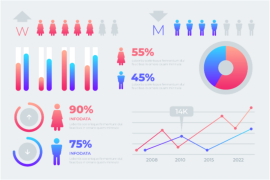
July 28, 2023, 8:35 am
As a dental practice, providing exceptional patient care and building lasting relationships with your patients are fundamental to your success. One powerful tool that can help you achieve these goals is data. Specifically, analyzing patient demographics can provide valuable insights that help you understand your patients better and tailor your services to meet their unique needs.
Why Patient Demographics Matter
Patient demographics refer to the characteristics and traits that define your patient population. These include age, gender, location, ethnicity, socioeconomic status, and other relevant factors. Understanding patient demographics is vital for several reasons:
1. Personalized Care: Patient demographics provide key insights into the diverse needs and preferences of your patients. This understanding allows you to deliver personalized care that caters to individual requirements.
2. Targeted Marketing: Analyzing patient demographics enables you to identify target audiences and design targeted marketing strategies. By tailoring your messages to specific patient groups, you can increase the effectiveness of your marketing efforts.
3. Enhanced Patient Communication: When you understand the demographics of your patient base, you can communicate with them in ways that resonate with their background and preferences. This fosters better patient engagement and communication.
4. Resource Allocation: Knowledge of patient demographics helps you allocate resources more efficiently. For instance, if you have a significant elderly population, you might invest in services and amenities that cater to their needs.
5. Community Engagement: Understanding patient demographics allows you to engage with the community more effectively. You can participate in local events and initiatives that align with the interests of your patient base.
How to Analyze Patient Demographics
To harness the benefits of patient demographic data, follow these steps for effective analysis:
1. Data Collection: Start by gathering relevant patient demographic data. This information can be collected through patient registration forms, electronic health records, and surveys.
2. Data Segmentation: Segment the data into meaningful categories. For instance, group patients by age groups, location, or specific health conditions.
3. Data Visualization: Utilize data visualization tools to present the demographic data in a clear and understandable format. Charts and graphs can help you identify trends and patterns at a glance.
4. Identify Trends and Insights: Analyze the data to identify trends and insights about your patient population. Look for common characteristics, preferences, and needs.
5. Apply Insights to Improve Care: Use the insights gained from the data analysis to inform your decision-making and patient care strategies. Tailor your services and communication to align with the unique needs of your patients.
Understanding your patient demographics through data analysis is a powerful tool that enables you to deliver exceptional care and build meaningful connections with your patients. By harnessing the insights from patient demographics, you can offer personalized care, design targeted marketing strategies, improve patient communication, allocate resources efficiently, and engage with the community effectively.
Embrace the value of patient demographic data and its impact on your dental practice. By utilizing data analysis to unlock the unique characteristics and needs of your patient base, you can elevate the level of care you provide and create a dental practice that truly understands and serves its patients in the best possible way. Remember, data is not just numbers; it is the key to unlocking the pathway to outstanding patient experiences and lasting relationships with your patients.
